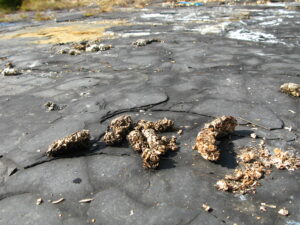
Raccoon Feces – Whether you find a concealed raccoon latrine in your yard or garden, or you come across raccoon feces while you are examining a possible animal problem in your attic or wall cavity, it is extremely important to deal with raccoon feces with care. It can transmit a number of various kinds of diseases, and there is frequently quite a lot of it, indicating that you need to be mindful and cautious when tidying up any raccoon feces. Undoubtedly, if you aren’t confident in handling the problem, and you’re worried the raccoon may still exist around your house, it would be a great idea to hire a professional wildlife removal expert to make sure there is no more risk from the animal. Grand Rapids Michigan raccoon removal has the experience to take care of any problem, big or small.
How to Deal With Animal Feces
Contents
Whether you are entering an area where there is likely to be a high concentration of animal feces or heading into a small space such as an attic that may contain feces, it is very important to take the right safety measures. Make sure you use appropriate long-sleeved clothes with thick material, in addition to thick gloves such as gardening gloves, ensuring that no skin comes into contact with the feces. A breathing mask will assist you to guarantee you do not inhale any airborne spores or particles, while eye goggles can also assist to keep them from getting in your body that way.
Recognizing Raccoon Feces
Raccoon feces will often look comparable to canine poop, with fairly long cylinders that are usually rather dry, and the feces will frequently have noticeable pieces of berry, which is normal of raccoon feces. Unlike other animals, raccoons will normally try and utilize one area as a latrine, where they will deposit most of their urine and feces, and seeing a concentration of feces in one area can also be a sign that it is raccoon feces that you are taking a look at.

Cleaning Raccoon Feces in an Attic of Wall Cavity
You likewise need to guarantee that you either have several black trash bags that can be used to carry the feces or a sealable container into which the feces can be transmitted. In numerous cases, insulation material will have been torn or greatly soiled by the raccoon feces, and in this case, it is normally best to change the material rather than clean it.
Getting Rid of Raccoon Feces
If you weren’t currently aware of the possibility of contamination and illness transmitted by raccoon feces, it is also really crucial that you deal with the feces correctly. If the product is in one trash bag, seal that bag, and place it within a second bag that is likewise sealed. This needs to be tough enough to keep the material inside and allow the bags to be put out with the trash, while a sealed container can likewise be put out in this manner. Nevertheless, you can also bury the material or incinerate it. Incineration make certain that no other damaging particles escape from the feces.
Diseases Transmitted by the Feces
Among the most common illness that can be transferred through raccoon feces is raccoon roundworm, and usually occurs when the eggs that are found in the feces are inhaled or swallowed. Symptoms can include respiratory problems, nausea, and a loss of balance. Giardia is another common illness transmitted through raccoon feces and can cause stomach cramps, queasiness, and diarrhea. Leptospirosis is another condition that can be contracted by those handling raccoon feces without taking the right precautions, and while signs such as headaches, jaundice, and fever can be early signs, in unusual cases it can have severe repercussions for the individual.
Carrying Out Repairs to Raccoon Damage
If you are handling an area that has been damaged by raccoons, it is really crucial that you want to make sure the safety of others that may need to get in that area or cavity in the future. This means getting rid of the feces properly, and after that disposing of the feces in such a way that will not harm anybody else along the way. Once this is done, make sure that you change any areas of insulation that have been soiled by the raccoon, and check on all wires and cables to ensure they haven’t been chewed by the raccoon.
Finally, ensure that the area is decontaminated with a disinfectant spray that will kill off any remaining germs or spores, and will allow you to begin safely utilizing the area again.
Also Read:
How Raccoons Get In Your House
